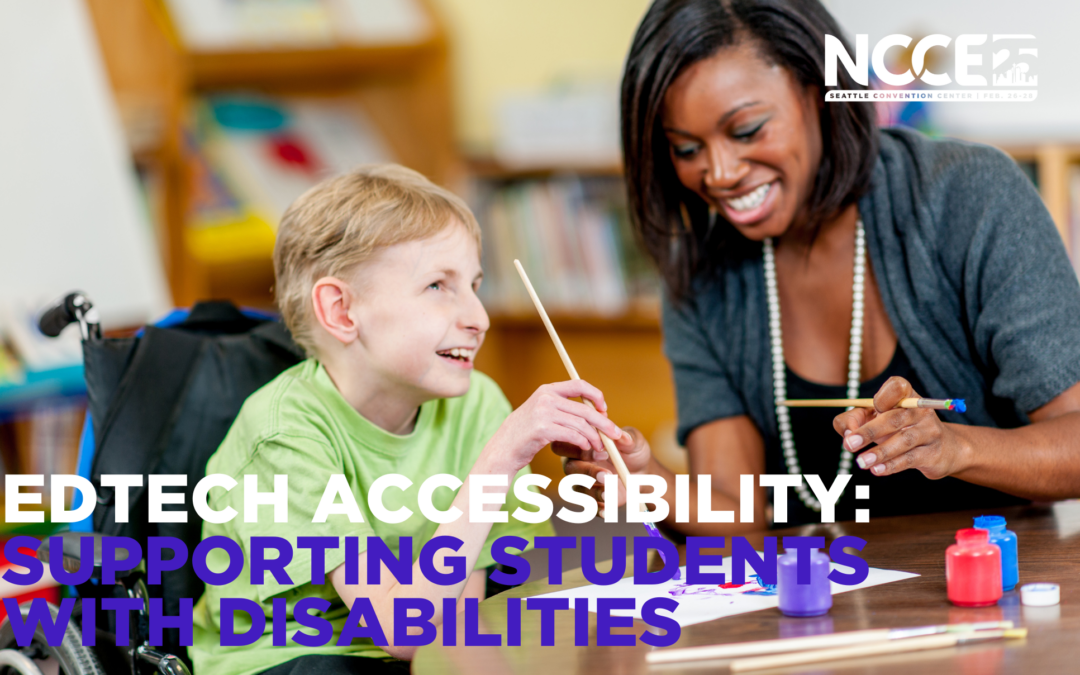Educational technology (EdTech) has revolutionized how educators teach and how students learn in many different arenas. As we celebrate advancements in online tools, virtual classrooms, and interactive learning platforms, one crucial aspect that should be celebrated is the capability of EdTech to increase educational accessibility for students with disabilities. Efforts to ensure that EdTech is inclusive can empower every student to succeed.
The Northwest Council for Computer Education (NCCE) has been at the forefront of the EdTech movement, and one of the core drivers of our efforts has been to expand the reach of education to groups who have typically had limited access to educational opportunities. According to the World Health Organization (WHO), more than 1 billion people globally live with some form of disability, and many of them are students. Disabilities may range from physical impairments, like mobility or vision challenges, to cognitive and neurodivergent conditions. The right tools and technology can open doors for these students that traditional methods might have kept closed.
Accessible EdTech bridges the gap between students with disabilities and their peers, creating learning opportunities that enable disabled learners to compete on par with other students. It helps all students to fully engage with a curriculum, participate in classroom activities and projects, and achieve their academic potential.
Key Features of Accessible EdTech
For EdTech to support students with disabilities, it must incorporate thoughtful design and functionality. Here are some of the most impactful features we have found for students facing various accessibility challenges:
- Screen Readers and Text-to-Speech Tools: Screen readers and text-to-speech tools enable students with visual impairments to access digital content by converting text into spoken words. These tools also assist students with dyslexia or other reading challenges.
- Closed Captioning and Transcripts: Videos and multimedia content should include closed captions and transcripts for students who are deaf or hard of hearing. These features provide equal access to audio-based content and foster better comprehension.
- Keyboard Navigation: Students with motor impairments or who cannot use a mouse often rely on keyboard navigation to use computers; these platforms can allow users to navigate all features using only a keyboard.
- Customizable Interfaces: Flexibility in font size, color contrast, and layout customization benefits students with low vision, color blindness, or cognitive disabilities. These adjustments can make interfaces easier to understand and engage with.
- Speech-to-Text: For students with mobility impairments or learning disabilities, speech-to-text technology offers a way to communicate, write, and participate in discussions.
- Alternative Input Devices: Technologies that support alternative inputs, like sip-and-puff devices or eye-tracking software, allow students with severe mobility challenges to interact with digital platforms.
The Role of Educators and Institutions
While the design and functionality of various EdTech tools are critical, the actions taken by educators and institutions play an equally vital role in fostering accessibility for their learning-challenged students. Here are actionable steps schools and educators can take to ensure that EdTech supports all learners:
- Select Accessible Tools: When choosing EdTech solutions, prioritize those that meet accessibility standards, such as the Web Content Accessibility Guidelines (WCAG) and Section 508 (of the Rehabilitation Act of 1973) compliance. Vendors should be transparent about their accessibility features.
- Provide Training: Both teachers and students need training on how to use accessible tools effectively. Educators should know how to adapt platforms for different needs and troubleshoot accessibility challenges to find optimal settings for individual students.
- Collaborate with Students and Families: Open communication with students with disabilities and their families is key to understanding specific needs. Their insights can guide the selection and implementation of accessible tools to maximize learning benefits to the student.
- Regularly Evaluate Accessibility: Technology evolves rapidly, and so do accessibility standards. Schools should periodically review their tools and processes to ensure they remain inclusive and effective, while actively seeking out new and innovative tools that may better meet their needs.
Real-World Impact of Accessible EdTech
Accessible EdTech has transformed education for countless students. Examples of tools that can transform the learning experience for students with disabilities may include:
- A student with cerebral palsy uses eye-tracking technology to communicate and participate in virtual group projects, breaking down barriers to collaboration.
- A visually impaired student accesses course materials independently through a screen reader, gaining confidence and reducing reliance on others.
- A student with dyslexia benefits from text-to-speech tools that make reading assignments less daunting, allowing her to focus on comprehension instead of struggling with text.
These examples demonstrate that accessible EdTech is not just a theoretical concept; it can be a game-changer that redefines the educational experience for students with disabilities, opening the door to new experiences and opportunities.
Moving Forward: Accessibility as a Priority
As technology continues to evolve, so must our commitment to accessibility. Developers, educators, and policymakers all have a role in creating a more inclusive learning environment. By prioritizing accessibility in EdTech design and implementation, we can break down barriers, foster equity, and ensure no student is left behind.
Accessibility is not just a checkbox; it’s a mindset. When we build technology that works for everyone, we create a future where all students can thrive, regardless of their abilities. For more resources on EdTech or to find tools that can help your school serve students with disabilities, contact NCCE today. Together, let’s embrace this opportunity to make education genuinely inclusive for all.

